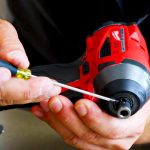The first time you need to trim back branches on a tree in your yard – you look up at the tangled mess of limbs and branches wondering how you’ll ever get up there to cut them without taking a fall. Sure you could pull out the old manual saw, but who wants to spend their Saturday sweating away at limbs they can barely reach?
That’s when you remember your trusty reciprocating saw tucked away in the garage. Its powerful motor and long razor-sharp blade make quick work of all sorts of materials. But can you really use this power tool designed for construction to prune back your tree branches?
Before you fire up the saw and start hacking away, it’s important to understand the basics of using this unexpected garden tool. In this guide, we’ll cover everything you need to know to safely and effectively use a reciprocating saw for cutting tree branches.
Can I Use a Reciprocating Saw to Cut Tree Branches?
The short answer is “Yes, you can use a reciprocating saw to cut tree branches”, but there are some important caveats.
Most reciprocating saws are capable of cutting through branches, provided the branch is not thicker than the width of the saw blade itself. The key things to keep in mind are using a sharp blade designed for cutting wood, and ensuring the teeth are set correctly for an efficient cutting motion against the grain of the branch.
Dull blades or incorrectly set teeth can cause the saw to bind up in the middle of thicker branches instead of slicing cleanly through them. Attempting to power through a partially cut branch puts excessive strain on the saw and risks overheating the motor.
For optimum results, choose a cordless reciprocating saw with a sturdy wood cutting blade at least 1/2″ to 3/4″ wide. Take care to start cuts gently to avoid tearing of the bark, and work in manageable sections for large branches. Let the saw do the work without forcing it.

For branches thicker than the saw blade capacity, use a reciprocating saw for the initial partial cut then finish the cut with a manual saw or loppers. Always observe proper safety precautions when using power saws on ladders or in trees.
How to Use a Reciprocating Saw to Cut Tree Branches?
While reciprocating saws are most commonly used for cutting construction materials, they can also be an effective tool for pruning and removing tree branches. With the right technique and safety precautions, a reciprocating saw makes quick work of large branches that would require significant time and effort with manual saws.
When using a reciprocating saw on trees, the key steps include selecting the proper woodcutting blade, adjusting the speed setting to match the branch size, making controlled cuts to establish the kerf, observing important safety measures, and finishing cuts flush with the tree trunk.
Pick the Right Blade
Selecting the right reciprocating saw blade is crucial for efficiently cutting tree branches. Avoid using old blades intended for metal or masonry that are likely worn out and damaged. Instead, choose a sharp woodcutting blade specifically designed for cutting tree limbs.
Look for a blade made from high-carbon steel that is thick and rigid enough to handle the density and diameter of branches without bending or dulling too quickly. The ideal wood blade will have aggressive teeth optimized for fast cuts across the grain of the wood.
Aim for a blade that is at least 1/2 inch wide up to 3/4 inch for maximum cutting capacity. The teeth should be large and evenly set to prevent binding or getting stuck in the middle of thicker branches. A blade with bi-metal construction maintains its sharp edge longer during prolonged use.
Before starting any cuts, inspect the blade to ensure the teeth are not bent, broken, or unevenly filed. Take the time to properly tension and track the blade on your saw for straight cuts that don’t veer or curve unexpectedly.
Speed Setting
The speed setting impacts cutting performance based on the thickness and density of the wood.
For pruning thinner branches up to 2-3 inches in diameter, use a slower speed setting. The reduced speed gives you more control to follow the contours of small branches without over-cutting. It also minimizes the risk of rapid blade binding or kickback on thin limbs.
When cutting thicker branches ranging from 3 inches up to the maximum capacity of your saw blade, increase to a faster speed setting. The higher strokes per minute deliver more power to quickly cut through dense wood. Just be cautious of potential kickbacks at maximum speeds.
Refer to your saw’s owner manual for technical guidance on optimal speed ranges based on the amperage and strokes per minute of your specific model. As a general rule, start at a moderate speed and adjust faster or slower as needed based on cut performance. The goal is to cut efficiently without excessive blade sticking or wear.
Run Blade to Make Cut
Once you have the right blade installed and speed setting adjusted, you’re ready to make the actual cut. Position the reciprocating saw at the base of the branch where it extends from the tree trunk. The blade should be perpendicular (at an angle of 90°) to the branch, not angled.

Gently ease into the branch to start the cut, letting the blade teeth gain purchase in the wood. Apply light pressure while slowly engaging the trigger to begin the sawing motion. This prevents the blade from skidding across the surface or gouging the bark.
As the cut establishes, you can increase the pressure and speed. Use smooth, sweeping motions to guide the blade back and forth through the wood. Avoid pushing too aggressively or forcing the blade through dense areas.
Maintain control of the saw to prevent sudden binding or kickback when the blade gets pinched. Cut in manageable segments, progressively working around the circumference of larger branches. Regularly pause to clear debris from the blade teeth as needed.
The key is using steady, continuous motion while letting the blade do the cutting work. Forcing the saw leads to mistakes, blade damage, and rough uneven cuts. Patience pays off with properly executed cuts.
Assure Safety
When using powerful reciprocating saws for tree branch removal, safety should be your top priority. This equipment can quickly cause injury if proper precautions aren’t taken.
Always wear eye protection such as safety glasses or a face shield to prevent debris from damaging your eyes. Ear protection like work earmuffs reduces exposure to the loud noise. Sturdy non-slip gloves improve your grip on the saw. And a hard hat is advised for protection from falling branches.
Maintain a stable, balanced stance when cutting overhead or high up on ladders. Keep your body parts away from the blade path and surrounding branches during cuts. Assume branches can snap or drop unpredictably.
Make sure bystanders and pets are at a safe distance from your work zone in case of falling limbs. Survey the area for any electrical wires tangled in the branches to avoid contact with the saw.
It only takes a moment for reciprocating saws to inflict severe lacerations when safety protocols aren’t followed. Stay alert, keep your distance from the blade, and wear protection to mitigate risks. Taking precautions will allow you to operate the saw confidently and prevent dangerous mishaps.
Finish the Cut
As you near the end of the cut, reduce pressure and speed to avoid damaging the tree as the branch detaches. Allow the blade to finish slicing all the way through the bottom of the branch cleanly.
Once the limb is completely severed, release the trigger and retract the saw carefully to prevent the limb from snapping back. Use caution as the full weight of the branch is now disconnected from the tree and can fall uncontrolled.
Take time to survey the tree and prune any other problematic branches that are dead, or damaged, or diseased. Make finishing cuts flush with the trunk or main branch collar for optimal healing. Avoid leaving branch stubs sticking out.
Finally, proper follow-through and inspection help ensure the tree’s health after pruning. But it takes experience to master reciprocating saw techniques for tree branches. Seek guidance from tree care professionals if unsure how to operate the saw safely. You can also check out the Usage Of Reciprocating Saw in detail which will help you to understand how it works.
Benefits Of Choosing Reciprocating Saw Over Traditional Saw
When choosing between a reciprocating saw and a traditional manual saw for cutting tree branches, the reciprocating saw has several notable benefits:

The fast reciprocating action of the blade powered by an electric motor allows for much quicker and more efficient cutting through branches. Even large-diameter logs and boughs can be pruned rapidly, saving significant time and energy compared to tedious manual sawing.
- Faster cutting speed and efficiency with electric power
- Saves time and energy pruning branches
The precision and control of a reciprocating saw enables cleaner, more accurate cuts. It’s easier to shape and direct tree growth as desired versus using a hand saw.
- Allows more precision and control when cutting
- Achieves accurate, clean branch cuts
The compact size and pivoting blade offer enhanced versatility. Reciprocating saws can access tight spaces around trees and cut at obtuse angles that long saw blades cannot fit.
- Compact size reaches tight spaces around trees
- Pivoting blade cuts at difficult angles
Overall, reciprocating saws enhance productivity, precision, and ease when trimming trees compared to traditional hand saws. Their safety and convenience make them a worthwhile investment for home DIYers and tree care professionals managing frequent pruning tasks.
Limitations and Challenges
While reciprocating saws can be effective tools for pruning tree limbs, they do have some limitations to consider:
- Not as precise as manual saws for detailed pruning or fine shaping. The rapid motion makes very precise, delicate cuts more difficult.
- Increased safety precautions are needed due to the exposed fast-moving blade. Risk of kickback or contact injuries. Chainsaws pose even greater risks.
- Learning curve to use properly compared to manual tools. Novice users should get training on correct techniques.
- Not well-suited for very thick tree limbs exceeding the blade capacity. Chainsaws work better for large-diameter logs.
- Less portable than hand saws for remote tree access. Requires battery charging or power cord.
- Aggressive cutting can tear bark or damage trees if used carelessly. Finesse is required.
- Reciprocating saws require careful maintenance and periodic blade replacement. Added costs of ownership.

With training and experience, the limitations can be managed. But reciprocating saws do demand respect for safe operation compared to basic hand saws. Understanding the challenges will lead to better results in pruning branches.
Best Blade To Cut Tree Branches By Using A Reciprocating Saw
With the wide variety of reciprocating saw blades available, choosing the right one for cutting tree branches can be confusing. Generally, you’ll want a blade with larger teeth and lower teeth per inch (TPI) to cut through wood efficiently. The best options for branch pruning are:
- Pruning Blades – Designed specifically for cutting small branches and pruning trees. Variable TPI through the blade length with irregular tooth pattern to clear sawdust.
- Firewood Blades – Rougher cutting blades ideal for medium to large branches. 3-5 TPI with large gullets to quickly cut wood. Made of durable high carbon or bi-metal steel.
- Wood Cutting Blades – General purpose wood blades with 8-14 TPI work well for branch cutting. The wavy set tooth pattern reduces binding in dense wood.
Look for a blade thickness of at least 1/2″ for sufficient cutting depth and rigidity. Large robust teeth prevent the blade from getting stuck in thicker branches. And make sure the teeth are sharp – dull teeth make cutting much more difficult.
With the right reciprocating saw blade matched to the branch size, you’ll achieve faster, cleaner cuts when pruning trees. Specialized pruning blades are best for detail work while more aggressive wood cutting or firewood blades tackle large branches with ease.
Wrapping Up
When used properly, reciprocating saws can be a great option for cutting tree branches thanks to their speed, power, and reach. However, the exposed blade poses risks if safety precautions aren’t taken. Investing the time to learn proper techniques and start slowly with lower branches is key.
With patience and the right blade choice, reciprocating saws allow faster, easier branch pruning compared to manual saws. They make a worthwhile addition to any homeowner or tree care pro’s toolkit if handled carefully. Just be sure to prioritize safety and care for the tree when substituting this power tool for hand saws.
Frequently Asked Questions (FAQs)
1. Can you cut wet wood with a reciprocating saw?
Ans – Yes, reciprocating saws can cut wet or green wood. The teeth on woodcutting blades are designed to chip through damp wood without excessive gumming. However, the cut may require more effort and progress slower in wet wood versus dried lumber.
2. Can a reciprocating saw overheat?
Ans – Yes, the motor can overheat if pushed too hard for too long, especially with an undersized model. Allow breaks for the saw to rest and cool periodically. Don’t force the blade if it starts slowing down. Overheating can cause permanent damage.
3. What safety gears and wearables should I take on before this process?
Ans – At a minimum, always wear eye protection, sturdy gloves, closed-toe shoes, and long pants when using a reciprocating saw. Hearing protection, a dust mask, and a hard hat are also recommended for overhead tree cutting.
4. Should I make a vertical cut or horizontal cut on tree branches while tree pruning with a reciprocating saw?
Ans – For most situations, a horizontal cut just outside the branch collar is recommended for proper healing. Vertical cuts can damage tree trunks. Proper technique is to cut from underneath the branch first, and then finish from the top.
5. How much thickness of tree branches can be dealt with a reciprocating saw?
Ans – It depends on the power and blade size, but generally 1.5-6 inches is reasonable for most models. Specialty saws can cut even thicker branches. Always use the appropriate size blade for the cut to avoid overloading.










Leave a Comment